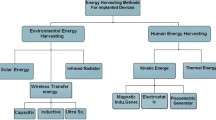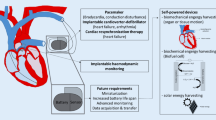Abstract
Implantable medical devices (IMDs) are critically requested for the survival of patients subject to certain serious diseases such as bradycardia, fibrillation, diabetes, and disability, etc. Appropriate working of an active implantable medical device (IMD) heavily relies on the continuous supply of electricity. In this sense, long-term powering and recharging of an IMD via a highly safe, efficient and convenient way is, therefore, extremely important in clinics. Several conventional batteries, such as lithium cell, nuclear cell and bio-fuel cell, etc., have been developed to power IMDs. Meanwhile, the recharge of IMD from outside of the human body is also under investigation. In this paper, some of the most typical IMD batteries are reviewed. Their advantages and disadvantages are compared. In addition, several emerging innovations to recharge or directly drive the implanted batteries, including electromagnetic energy transmission, piezoelectric power generation, thermoelectric devices, ultrasonic power motors, radio frequency recharging and optical recharging methods, etc., are also discussed. Some fundamental and practical issues thus involved are summarized, and future prospects in this area are made.
Similar content being viewed by others
References
Molina-Negro P. Role of neurostimulators in the treatment of chronic refractory pain. Union Med Can, 1980, 109(1): 41–54
Wang F, Hua W, Zhang S, et al. Clinical survey of pacemakers 2000–2001. China J Carcdiac Arrhyth, 2003, 7:189–191
Zeng F G, Bai J Y. Trends in cochlear implant. Trends Amplif, 2004, 8: 1–34
Gopal Santhanam, Stephen I R, Byron M Y, et al. A highperformance brain-computer interface. Nature, 2006, 442:195–198, 2006
Soykan O. Power sources for implantable medical devices. 2003, http://www.bbriefings.com/businessbriefing/testimonial/
Szczesny S, Jetzki S, Leonhardt S. Review of current actuator suitability for use in medical implants. Proceedings of the 28th IEEE, EMBS Annual International Conference, New York, 2006: 5956–5959
Antonioli G, Baggioni F, Consiglio F, et al. Stinulatore cardiaco impiantabile con nuova battaria a stato solido al litio. Minerva Med, 1973, 64: 2298–2305
Mallela V S, Ilankumaran V, Rao N S. Trends in cardiac pacemaker batteries. Indian Pacing and Electrophysiology Journal, 2004, 4: 201–212
Holmes C F. The role of lithium batteries in modern health care. Journal of Power Sources. 2001, 97: 739–741
Drews J, Fehrmann G, Staub R, et al. Primary batteries for implantable pacemakers and defibrillators. Journal of Power Sources, 2001, 97: 747–749
Spillman D M, Takeuchi E S. Lithium ion batteries for medical devices. The 14th Annual Battery Conference on Applications and Advances, California State University, Long Beach, 1999: 203–208
Li M, Tao Z, Zhao Y, et al. Lithium Iodine Batteries used in pacemaker. Chinese Journal of Power Sources, 1990, 1: 5–8.
Zhang B, Ni S. Introduction to electrochemical power sources. Shanghai: Shanghai Jiaotong University Press, 1992
Bullen R A, Arnot T C, Lakeman J B, et al. Biofuel cells and their development. Biosensors and Bioelectronics, 2006, 21:2015–2045
Potter M C. Electrical effects accompanying the decomposition of organic compounds. Proceedings of Royal Society, 1911, 84: 260–276
Cohen B. The bacterial culture as an electrical half-cell. Journal of Bacteriol, 1931, 21: 18–21
Yahiro A T, Lee S M, Kimble D O. Bioelectrochemistry.I. Enzyme utilizing bio-fuel cell study. Biochim.Biophys Acta, 1964, 88: 375–383
Heller A. Miniature biofuel cells. Phy Chem Chem Phy. 2004, 6: 209–216
Bullen R A, Arnot T C, Lakeman J B, et al. Biofuel cells and their development. Biosensors & bioelectronics, 2006, 21:2015–2045
Kang F, Wu Y, Li D. Reserch progress in biofuel cell. Chinese Journal of Power Fources, 2004, 28: 723–727
Hellwell C M, Simon E, Toh C S, et al. Immobilisation of lactate dehydrogenase on poly (aniline)-poly (acrylate) and poly (aniline) poly (vinyl sulphonate) films for use in a lactate biosensor. An alytica Chimica Acta. 2002, 453: 191–200
Hellwell C M, Simon E, Toh C S, et al. The design of dehydrogenase enzymes for use in a biofuel cell: the role of genetically introduced peptide tags in enzyme immobilization on electrodes. Bioelectrochem, 2002, 55: 21–23
Simon E, Hellwell C M, Toh C S, et al. Immobilisation of enzymes on poly(aniline)-poly(anion) composite films prepartion of bioanodes for biofuel cell applications. Bioelectrochem, 2002, 55: 13–15
Mano N, Kim H H, Heller A. On the relationship between the characteristics of bilirude oxidases an d O2 cathodes based on their “wiring”. Journal of Physical and Chemistry B, 2002, 34: 8842–8848
Mano N, Kim H H, Zhang Y, et al. An oxygen cathode operating in a physiological solution. Journal of American Chemical Society, 2002, 124: 6480–6486
Katz E, Willner I, Kotlyer A B. A non-compartmentalized glucose O2 biofuel cell by bioengineered electrode surface. J Electroan Chem, 1999, 479: 64–68
Willner I, Vered H S, Katz E, et al. Integration of a reconstituted de novo synthesized hemoprotein and native metalloproteins with electrode supports for bioelectronic and bioelctrocatalytic application. Journal of American Chemical Society, 1999, 121: 6455–6468
Mano N, Mao F, Heller A. Micro-fuel cell operating in a grape. Journal of American Chemical Society, 2003, 125:6588–6594
Zhu Z, Monmeu C, Zakhartsev M, et al. Making glucose oxidase fit for biofuel cell applications by directed protein evolution. Bionsensors and Bioelectronics, 2006, 21: 2046–2051
Frank D, Higson P J S. Biofuel cells-Recent advances and applications. Biosensors and Bioelectronics, 2007, 22: 1224–1235
Wen H K, Hynecek J. Implant evaluation of a nuclear power source-batacel battery. IEEE transactions on Biomedical Engineering, 1974, 21: 238–241
Parsonnet V, Villanueva A, Driller J, et al. Corrosion of Pacemaker Electrodes, Pace, 1981, 4: 289–296
Prutchi D. Nuclear pacemakers. URL:http://home.comcast.net/:_dprutchi/nuclear_pacemakers.pdf
Suzuki S, Katane T, Saotome H, et al. A proposal of electric power generating system for implanted medical devices. IEEE Transactions on Magnetics, 1999, 35: 3586–3589
Suzuki S, Katane T, Saotome H, et al. Electric power-generating system using magnetic coupling for deeply implanted medical. IEEE Transactions on Magnetics, 2002, 38: 3006–3008
Spencer W J, Corbett W T, Dominguez L R, et al. An electronically controlled piezoelectric insulin pump and valves. IEEE Transactions on Sonics and Ultrasonic, 1978, 25: 153–156
Geipel A, Doll A, Goldschmidtboing F, et al. Pressure-independent micropump with piezoelectric valves for low flow drug delivery systems. 19th IEEE International Conference on Micro Electro Mechanical Systems, Lütfi Kirdar Convention and Exhibition Centre, Istanbul, 2006: 786–789
Yang R, Zhang M, Tarn T J. Dynamic modeling and control of a micro-needle integrated piezoelectric micro-pump for diabetes care. Proceedings of the 2006 IEEE Conference on Nanotechnology, 2006, 1: 146–149
Williams C B, Yates R B. Analysis of a micro-electric generator for Microsystems. The 8th International Conference on Solid-State Sensors and Actuators, 1995, 1:369–372
Glynne P J, Beeby S P, White N M. Towards a piezoelectric vibration-powered microgenerator. IEE Proceedings on Science Measurement and Technology, 2001, 148: 68–72
Kymissis J, Kendall C, Paradiso J, et al. Parasitic power harvesting in shoes. Proceeding of the Second IEEE International Conference on Wearable Computing, Pittsburgh, 1998: 132–139
Wang Z L, Song J. Piezoelectric nanogenerators based on zinc oxide nanowire arrays. Science, 2006, 312: 242–246
Glosch H, Ashauer M, Pfeiffer U, et al. A thermoelectric converter for energy supply. Sensors and Actuators A: Physics, 1999, 74: 246–250
Boettner H, Nurnus J, Gavrikov A, et al. New thermoelectric components using microsystem technologies. Journal of Microelecromechanical Systems, 2004,13: 414–420
Lin J R, Snyder G J, Huang C K, et al. Thermoelectric microdevice fabrication process and evaluation. Proceedings of the 21st IEEE international Conference on Thermoelectrics, Long Beach, CA, 2002: 535–539
Wang W, Jia F, Huang Q, et al. A new type of low power thermoelectric micro-generator fabricated by nanowire array thermoelectric material. Microelectronic Engineering, 2005, 77: 223–229
Weber J, Potje-Kamloth K, Haase F, et al. Coin-size coiled-up polymer foil thermoelectric power generator for wearable electronics. Sensors and Actuators A: Physics, 2006, 132: 325–330
Yang Y, Wei X J, Liu J. Evaluation on the power generation capacity of a thermoelectric generator implanted in the biotissue. Journal of Physics D, Applied Physics, 2007, 40: 5790–5800
Meindl J D. Integrated electron devices in medicine. International Electron Devices Meeting, 1977, 23: 1A–1D
Phillips WB, Towe B C, Larson P J. An ultrasonically-driven piezoelectric neural stimulator. Proceedings of the 25th Annual International Conference of the IEEE, 2003, 2:1983–1986
Wang X, Song J, Liu J, et al. Direct-Current Nanogenerator Driven by Ultrasonic Waves. Science, 2007, 316:102–105
Zhang H. Design and experiment of transdermal RF powersupply of in vivo implantable system. Journal of Hefei University of Technology, 1999, 22: 94–98
Murakawa K, Kobayashi M, Nakamura O, et al. A wireless near-infrared energy system for medical implants. IEEE Engineering in Medicine and Biology Magazine, 1999, 6:70–72
Naresh K P, Vishrut C K. A high efficiency optical power transmitting system to a rechargeable lithium battery for all implantable biomedical devices. 3rd Kuala Lumpur International conference on biomedical engineering, 2007, 14: 533–537
Author information
Authors and Affiliations
Corresponding author
Rights and permissions
About this article
Cite this article
Wei, X., Liu, J. Power sources and electrical recharging strategies for implantable medical devices. Front. Energy Power Eng. China 2, 1–13 (2008). https://doi.org/10.1007/s11708-008-0016-3
Received:
Accepted:
Issue Date:
DOI: https://doi.org/10.1007/s11708-008-0016-3




